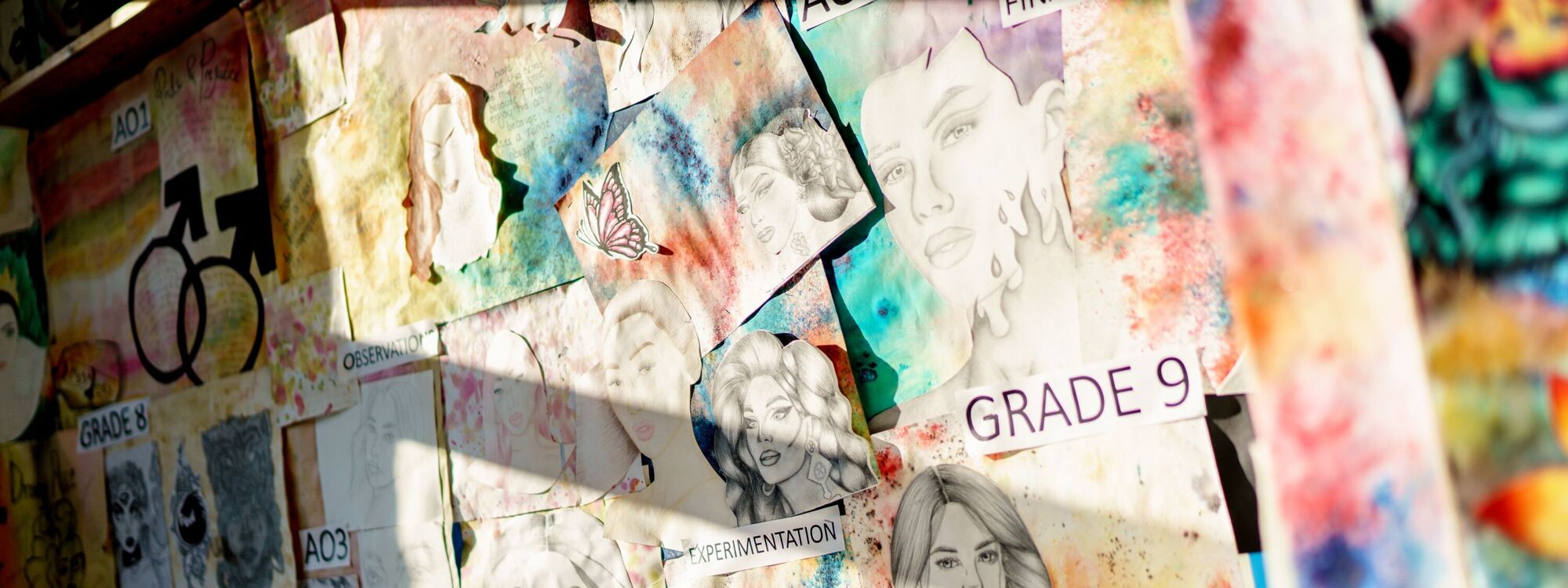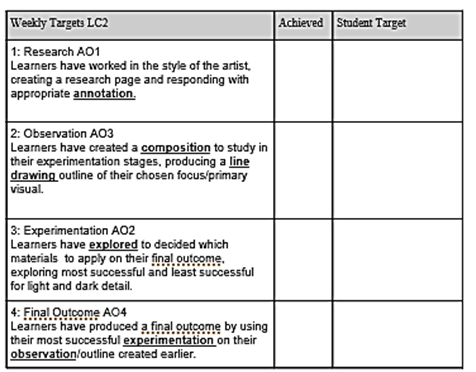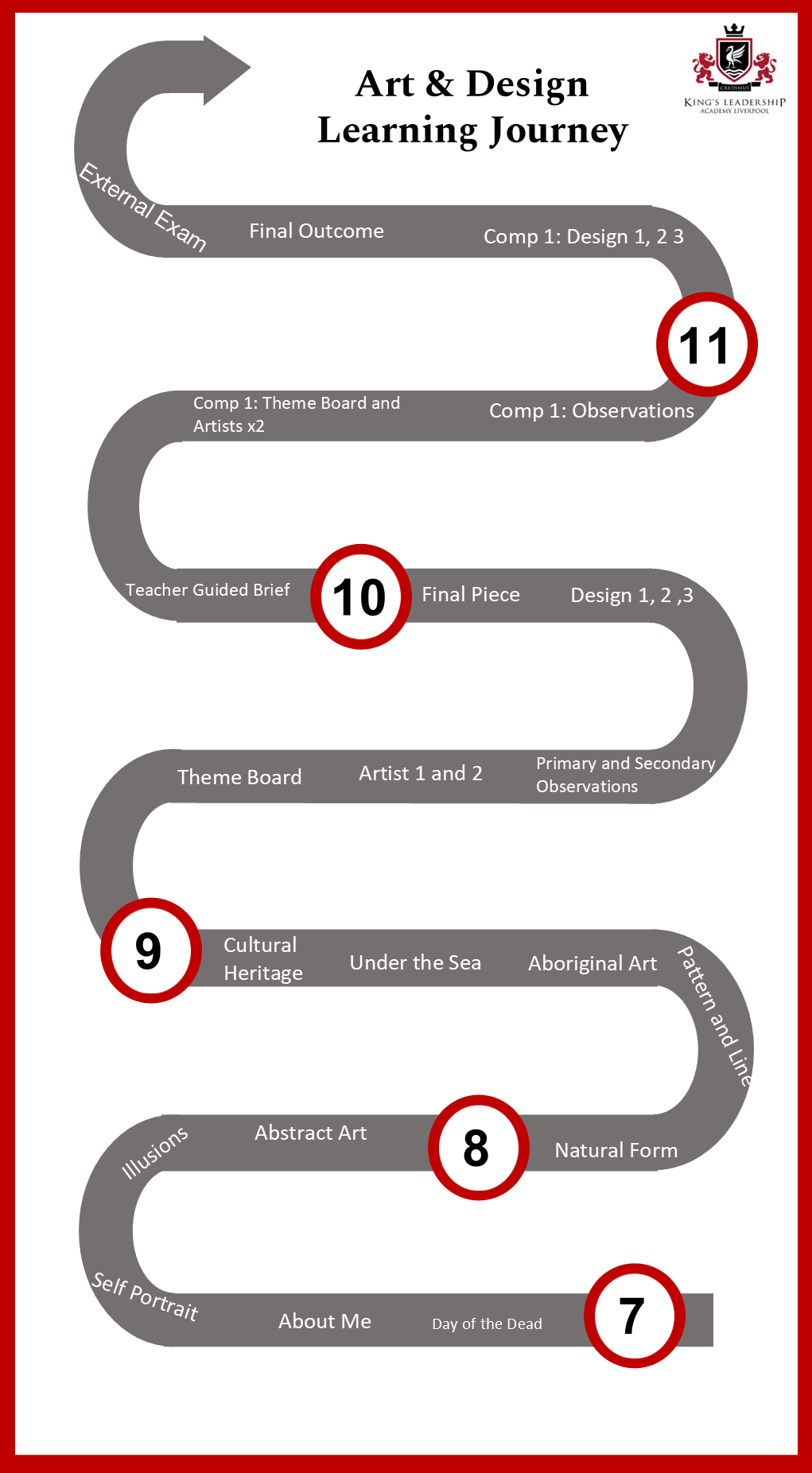
- Home
- About Us
- Our Curriculum
- Subjects
- Art and Design
Art and Design
BackHead of Subject:
Ms A Postlethwaite (Lead Practitioner)
Teaching Staff:
Mr R Orme
Curriculum Rationale
Art is a vital part of the curriculum, fostering creativity, critical thinking, and emotional expression. Through visual arts, students develop key skills such as problem-solving, collaboration, communication, and cultural awareness. Arts education encourages innovative thinking, builds confidence, and helps students explore diverse perspectives. The goal is to nurture well-rounded individuals who can approach challenges with creativity and empathy, and who appreciate the role of the arts in society and personal growth.
KS3 (Years 7-9)
Skills
Formal elements in art, such as line, shape, form, colour, texture, space, and value, are fundamental tools artists use to create and organise visual compositions. Mastering these elements helps students develop key skills in observation, expression, and design. Understanding how lines create movement, how shapes and forms structure a piece, or how colour and value affect mood and contrast enables students to communicate ideas more effectively. By applying these principles, students learn to analyse and construct visual art with purpose and clarity, enhancing both their technical abilities and artistic creativity.
Topics
Year 7: Day of the Dead, About me, Self Portrait, Abstract Art, Cubsim
Year 8: Natural Form, Pattern, Aboriginal Art, Under the Sea, Cultural Appreciation
Year 9: Natural Form, Georgia Okeeffe, Amira Gale, Observation studies, Experimentation and Final Response
Assessment
Outcomes and PLC/Success criteria per project

GCSE (Year 10-11)
Skills
Formal elements in art, such as line, shape, form, colour, texture, space, and value, are fundamental tools artists use to create and organise visual compositions. Mastering these elements helps students develop key skills in observation, expression, and design. Understanding how lines create movement, how shapes and forms structure a piece, or how colour and value affect mood and contrast enables students to communicate ideas more effectively. By applying these principles, students learn to analyse and construct visual art with purpose and clarity, enhancing both their technical abilities and artistic creativity.
Topics
Component 1: Mini brief and External Exam
Component 2: Themes, Artists, Observations, Experimentation and Outcome
Plus three projects throughout 2 year course
Assessment
- Assessment Trackers
- 10 hour exam per component for response
- Internal Moderation
- External Visit through AQA Exam Board
Here is the link to the exam board specification where the marking success criteria is clearly stated for all students, parents, carers and staff to access:
Clubs & Trips
Thursday: Art Club (after school)
Saturday Academy: Specific dates (GCSE only)
Careers
Art offers a wide range of career paths, blending creativity with technical skills across various industries. Some of the key options include:
1. Fine Artist: Traditional careers like painting, sculpture, or mixed media, where artists create original works to exhibit or sell.
2. Graphic Designer: Focuses on creating visual content for digital or print media, using design software to produce logos, advertisements, and branding materials.
3. Illustrator: Specialises in drawing and creating imagery for books, magazines, or online platforms, often collaborating with writers and publishers.
4. Animator: Works in film, television, video games, or online media to create motion graphics and animated sequences.
5. Art Director: Oversees the visual style and design in advertising, media, or product design, coordinating with teams to achieve creative goals.
6. Curator or Gallery Manager: Responsible for organising art exhibitions and managing art collections in museums or galleries.
7. Art Teacher/Educator: Instructs students in various art forms, from school to higher education settings.
These careers span industries like entertainment, publishing, marketing, and education, demonstrating how art skills are valuable in both creative and corporate environments.
Homework & Revision
Set: 1 project per term for KS3, Weekly at KS4.
Due day: Subject to circumstance see class charts
Format/platform: Class Charts, KS3 Sketchbooks and KS4 Coursework based in folder work
Wider Reading
Here are some valuable online resources to help GCSE and KS3 art students with their research, skills development, and project work:
1. BBC Bitesize - Art & Design (GCSE and KS3)
○ A comprehensive resource with lessons on key art techniques, movements, and skills, specifically tailored to UK curricula.
○ BBC Bitesize GCSE Art & Design
○ BBC Bitesize KS3 Art & Design
2. Tate Kids
○ Fun, interactive content that introduces art history, famous artists, and hands-on activities to help students explore different artistic styles.
3. The Art Story
○ Detailed information on art movements, styles, and influential artists, which can be useful for art students’ research and inspiration.
4. National Gallery - Learning Resources
○ Resources and guides for students to study famous artworks, artists, and techniques.
5. Art UK
○ A database of UK’s public art collections, offering students access to thousands of artworks for study and inspiration.
These resources support students in expanding their understanding of art concepts, techniques, and history.
Learning Journey
